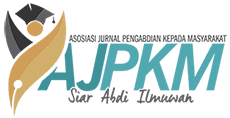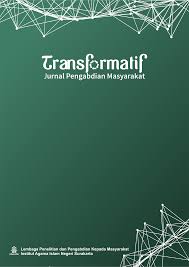Melatih Kemampuan Berkomukasi Siswa Melalui Engineering Design Process Pada Edukasi Hydromodelling
Main Article Content
Deny Nusyirwan
Seiring dengan perubahan sifat dan tampilan tempat kerja, tuntutan terhadap pendidikan juga ikut berubah, demikian juga kompetensi yang dibutuhkan. Pengusaha saat ini mengharapkan formal pendidikan yang mampu menawarkan pembelajaran yang memungkinkan kemampuan untuk beradaptasi dan fleksibilitas, serta menciptakan tenaga kerja terampil dalam berkomunikasi. Selain itu, di tengah pasar yang berubah dengan cepat maka diperlukan tenaga kerja yang mudah menerapkan pengetahuan dan keterampilan dalam situasi baru. Untuk membantu sekolah agar siswa berkembang di dunia yang berubah dengan cepat ini, program studi teknik perkapalan bersama-sama dengan sekolah bekerja sama untuk membantu siswa dapat mengembangkan kompetensi Abad 21 di era revolusi industri 4.0 dengan memperkenalkan Engineering Design Process pada Pelatihan Hydromodelling. Dengan dibangun di atas landasan karakter dan kompetensi abad 21 yang kuat diharapkan memungkinkan siswa untuk berkembang di dalam dan di luar sekolah, dan belajar serta bekerja di lingkungan yang berubah dengan cepat. Pelatihan telah mendapatkan sambutan baik dari para siswa yang ditampilkan dengan antusiasme pada awal hingga ahir pelatihan
Alacam, S., Findik, Y., and Balcisoy, S., (2018). Low-Fidelity Prototyping With Simple Collaborative Tabletop Computer-Aided Design Systems, Computers & Graphics, 70, pp. 307-315. https://doi.org/10.1016/j.cag.2017.07.026
Chen, U., and Sass, L., (2016). Fresh Press Modeler: A Generative System For Physically Based Low Fidelity Prototyping, Computers & Graphics, 54, pp. 157-165. https://doi.org/10.1016/j.cag.2015.07.003
Dilekçi, A., and Karatay, H., (2023). The effects of the 21st century skills curriculum on the development of students’ creative thinking skills, Thinking Skills and Creativity, 47, pp. 101229. https://doi.org/10.1016/j.tsc.2022.101229
Elverum, C., W., Welo, T., and Tronvoll, S., (2016). Prototyping in New Product Development: Strategy Considerations, Procedia CIRP, 50, pp. 117-122. https://doi.org/10.1016/j.procir.2016.05.010
Gerber, E., and Carroll, M., (2012). The Psychological Experience Of Prototyping, Design Studies, 33(1), pp. 64 84.https://doi.org/10.1016/j.destud.2011.06.005
Hall., R. (2001). Prototyping For Usability Of New Technology, International Journal of Human-Computer Studies, 55(4), pp. 485-50. https://doi.org/10.1006/ijhc.2001.0478
Haustein, H.,D., Maier, H., and Robinson, J., (1979). Thinking about Appropriate Technology, IFAC
Mallam, S., C., Lundh, M., and MacKinnon, S., N., (2017). Evaluating a digital ship design tool prototype: Designers’ perceptions of novel ergonomics software, Applied Ergonomics, 59, pp. 19-26. https://doi.org/10.1016/j.apergo.2016.08.026
Montt-Blanchard, D., Najmi, S., and Spinillo, C., G., (2023). Considerations For Community Engagement In Design Education, She Ji: The Journal of Design, Economics, and Innovation, 9(2), pp. 234-263. https://doi.org/10.1016/j.sheji.2023.05.004
Rodriguez-Calero, I., B., Coulentianos, M., J., Daly, S., R., Burridge, J., and Sienko, K., H., (2020). Prototyping Strategies For Stakeholder Engagement During Front-End Design: Design Practitioners’ Approaches In The Medical Device Industry, 71, pp. 100977. https://doi.org/10.1016/j.destud.2020.100977
Saleem, S., Dhuey, E., White, L., and Perlman, M., (2024). Understanding 21st Century Skills Needed In Response To Industry 4.0: Exploring Scholarly Insights Using Bibliometric Analysis, Telematics and Informatics Reports, Telematics and Informatics Reports, 13, pp. 100124. https://doi.org/10.1016/j.teler.2024.100124
SMK Perkapalan Hang Tuah, Tanjung Uban, Kabupaten Bintan, Provinsi Kepulauan Riau, https://maps.app.goo.gl/nbLgVYd9MreatQUf6, diunduh pada Senin, 20 Mei 2024 07:00
Tang, A., Aleti, A., Burge, J., and van Vliet, H., (2010). What makes software design effective?, Design Studies, 31, pp. 614-640. https://doi.org/10.1016/j.destud.2010.09.004
van Laar, E., van Deursen, A., J., A., M., van Dijk, J., A., G., M., and de Haan., J., (2017). The relation between 21st-century skills and digital skills: A systematic literature review, Computers in Human Behavior, 72, pp. 577-588.. https://doi.org/10.1016/j.chb.2017.03.010
Wen-Long, C., and Chun-Yi, L., (2013). Trust As A Learning Facilitator That Affects Students' Learning Performance In The Facebook Community: An Investigation In A Business Planning Writing Course, Computers & Education, 62, pp. 320-327. https://doi.org/10.1016/j.compedu.2012.11.007
Wessel, M., Thies, F., and Benlian, A., (2022). The Role Of Prototype Fidelity In Technology Crowdfunding, Journal of Business Venturing, 37(4), pp. 106220. https://doi.org/10.1016/j.jbusvent.2022.106220.











